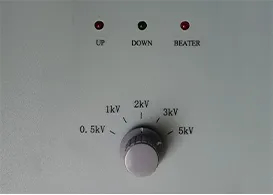 English
English


tan delta test of transformer bushing
Tan Delta Test of Transformer Bushings
The transformer bushing is a critical component that facilitates electrical insulation between the high-voltage components inside a transformer and the external environment. Due to their vital role in the overall functioning of transformers, it is essential to ensure that bushings are in good condition to prevent failures that could lead to significant downtime, costly repairs, and safety hazards. One of the key diagnostic tests performed on transformer bushings is the Tan Delta test.
The Tan Delta test, also known as the Power Factor test, is a diagnostic tool used to assess the insulation condition of transformer bushings. The test measures the dielectric losses in the insulating material as a function of the applied voltage. By calculating the tangent of the delta angle (the ratio of the resistive current to the capacitive current), this method provides insights into the quality and integrity of the bushing’s insulation.
During the test, a high-voltage alternating current is applied through the bushing, while specialized equipment measures the current and voltage. The data collected helps to quantify the power factor, where a lower power factor indicates better insulation quality. A higher power factor (or Tan Delta value) suggests increased dielectric losses, which can be indicative of moisture ingress, contamination, or degradation of the insulating material.
The results of the Tan Delta test can be used in several ways
1. Condition Assessment It enables utilities and maintenance personnel to gauge the health of the bushing insulation. Consistent and regular monitoring allows for timely interventions, preventing catastrophic failures.
tan delta test of transformer bushing

2. Preventive Maintenance By identifying abnormal Tan Delta values, maintenance can be performed proactively. This might include drying out the bushing or replacing it entirely before it leads to transformer failure.
3. Benchmarking The Tan Delta test provides a baseline for comparing bushing conditions over time. This can help in establishing trends that might indicate a degradation in performance, allowing for more informed maintenance decisions.
4. Risk Management Understanding the health of transformer bushings contributes to the overall risk management strategy of electrical utilities. By ensuring that all components are in optimal condition, utilities can enhance reliability and minimize the risk of outages.
While the Tan Delta test is extremely valuable, it is important to note that it should be conducted under controlled conditions by trained professionals. Proper calibration of the testing equipment and adherence to safety protocols is crucial, given the high voltages involved.
In conclusion, the Tan Delta test of transformer bushings is a significant diagnostic tool in the maintenance and operation of electrical transformers. By providing valuable insights into the insulation condition of bushings, it helps stakeholders ensure reliability, enhance safety, and optimize the lifespan of transformers. Regular testing not only aids in identifying potential issues early but also plays a crucial role in preventive maintenance strategies, ensuring that transformers operate efficiently in the challenging environments they often encounter.
-
Differences between open cup flash point tester and closed cup flash point testerNewsOct.31,2024
-
The Reliable Load Tap ChangerNewsOct.23,2024
-
The Essential Guide to Hipot TestersNewsOct.23,2024
-
The Digital Insulation TesterNewsOct.23,2024
-
The Best Earth Loop Impedance Tester for SaleNewsOct.23,2024
-
Tan Delta Tester--The Essential Tool for Electrical Insulation TestingNewsOct.23,2024





